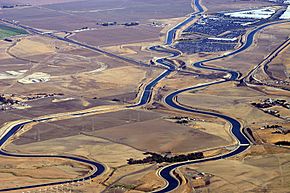California Aqueduct facts for kids
Quick facts for kids
California Aqueduct
|
|
|---|---|

The Delta–Mendota Canal (left) and the California Aqueduct (right) near Tracy, California
|
|
| Begins | Clifton Court Forebay, Contra Costa County 37°49′48″N 121°33′25″W / 37.829927°N 121.556894°W |
| Ends | West Branch Castaic Lake, Los Angeles County 34°35′15″N 118°39′25″W / 34.587379°N 118.656893°W East Branch Silverwood Lake, San Bernardino County 34°18′12″N 117°19′12″W / 34.303457°N 117.319908°W Coastal Branch Lake Cachuma, Santa Barbara County 34°35′12″N 119°58′52″W / 34.586656°N 119.980975°W |
| Official name | Governor Edmund G. Brown California Aqueduct |
| Maintained by | California Department of Water Resources |
| Characteristics | |
| Total length | Total: 444 mi (715 km) Main: 304 mi (489 km) East Branch: 140 mi (230 km) |
| Width | 110 ft (34 m) max. |
| Height | 40 ft (12 m) max. |
| Capacity | 13,100 cu ft/s (370 m3/s) max |
| History | |
| Construction start | 1963 |
| Opened | Coastal Branch 1997 |
The California Aqueduct is a giant system of canals and pipes. It helps move water across California. This amazing aqueduct brings water from the wet northern parts of the state. It carries it all the way to the drier central and southern areas. This water is super important for farms, cities, and people living there.
Contents
What is the California Aqueduct?
The California Aqueduct is a huge waterway. It's part of the California State Water Project. This project moves water from the Cascade Range mountains. It travels about 715 miles (1,151 km) south. The aqueduct is made of many parts. These include canals, pipelines, tunnels, and pumping plants.
Why is the Aqueduct Important?
California has a unique climate. The northern part gets a lot of rain and snow. But the central and southern parts are much drier. They need water for drinking, farming, and businesses. The California Aqueduct helps balance this. It moves water from where it's plentiful to where it's needed most.
How Does the Aqueduct Work?
The aqueduct starts in Contra Costa County. This is in northern California. Water is collected from rivers and streams. Then, powerful pumps lift the water over mountains. It flows through long canals and tunnels. The water travels downhill using gravity when possible. Along its path, the aqueduct fills up several large reservoirs. These include Bethany, Castaic, and Silverwood. These reservoirs store water for later use.
Branches of the Aqueduct
The California Aqueduct has different branches. These branches deliver water to specific areas.
- The West Branch carries water to Los Angeles County. It ends at Castaic Lake.
- The East Branch sends water to San Bernardino County. It finishes at Silverwood Lake.
- The Coastal Branch delivers water to Santa Barbara County. It ends at Lake Cachuma.
Each branch helps make sure water reaches different communities.
Building the Aqueduct
Building such a massive system was a huge challenge. Construction started in 1963. It took many years to complete. The Coastal Branch, for example, opened in 1997. Thousands of people worked on this project. They dug canals, built tunnels, and installed pumps. It was one of the biggest construction projects in California's history.
Facts and Figures
- The entire system is about 444 miles (715 km) long.
- The main part of the aqueduct is 304 miles (489 km) long.
- It can be up to 40 feet (12 meters) deep.
- It can be up to 110 feet (34 meters) wide.
- The aqueduct can carry a lot of water. It can move up to 13,100 cubic feet (371 cubic meters) of water every second. That's like filling a swimming pool in just a few seconds!
Who Manages the Aqueduct?
The California Department of Water Resources takes care of the aqueduct. They make sure it works properly. They also manage the water supply. This includes deciding how much water goes to farms and cities. Their job is to keep the water flowing safely and efficiently.
Images for kids
-
Aqueduct and surrounding farms in Kern County
See also
 In Spanish: Acueducto California para niños
In Spanish: Acueducto California para niños




